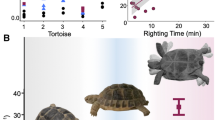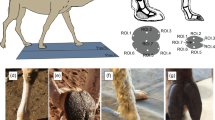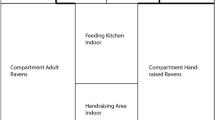Abstract
The fine-branch niche is a natural setting found among the slender vines and terminal branches of shrubs and tree canopies. In this study, the authors designed two simulations of this setting for laboratory mice. Their main goal was to model phenotypic plasticity in a small, clawed mammal, in order to better understand the effect of a thin-branch arboreal setting on musculoskeletal growth and behavior of these animals. The authors exposed mice to the smaller climbing setting for limited amounts of time (e.g., 30 min) and used the larger setting to permanently house another group of mice. Mice in both the limited and continuous climbing groups succeeded at quadrupedal climbing among a complex of thin branch segments. This led the authors to postulate that similarly sized pre-primates that lacked the unique features of today's primates could potentially have exploited this niche. The mice housed in the continuous model remained healthy and showed no signs of aggression, leading the authors to suggest that animal care personnel could use similar models as forms of enrichment for laboratory mice.
This is a preview of subscription content, access via your institution
Access options
Subscribe to this journal
We are sorry, but there is no personal subscription option available for your country.
Buy this article
- Purchase on Springer Link
- Instant access to full article PDF
Prices may be subject to local taxes which are calculated during checkout




Similar content being viewed by others
References
Smith, T., Rose, K.D. & Gingerich, P.D. Rapid Asia-Europe North America geographic dispersal of earliest Eocene primate Teilhardina during the Paleocene-Eocene Thermal Maximum. Proc. Natl. Acad. Sci. USA 103, 11223–11227 (2006).
Cartmill, M. Arboreal adaptations and the origin of the order Primates. in The Functional and Evolutionary Biology of Primates (Tuttle, R.H., ed.) 97–122 (Aldine-Atherton, Chicago, 1972).
Cartmill, M. Rethinking primate origins. Science 184, 436–443 (1974).
Szalay, F.S. Paleobiology of the earliest primates. in The Functional and Evolutionary Biology of Primates (Tuttle, R.H., ed.) 3–35 (Aldine-Atherton, Chicago, 1972).
Szalay, F.S. & Delson, E. Evolutionary History of the Primates (Academic, New York, 1979).
Szalay, F.S., Rosenberger, A.L. & Dagosto, M. Diagnosis and differentiation of the order primates. Am. J. Phys. Anthropol. 30, 75–105 (1987).
Gebo, D.L. A shrew-sized origin for primates. Am. J. Phys. Anthropol. 125, 40–62 (2004).
Gebo, D.L., Dagosto, M., Beard, K.C., Qi, T. & Wang, J. The oldest known anthropoid postcranial fossils and the early evolution of higher primates. Nature 404, 276–278 (2000).
Gebo, D.L., Dagosto, M., Beard, K.C. & Qi, T. The smallest primates. J. Hum. Evol. 38, 585–594 (2000).
Beard, K.C. et al. New sivaladapid primates from the Eocene Pondaung formation of Myanmar and the anthropoid status of Amphipithecidae. in Mammalian paleontology on a global stage: papers in honor of Mary R. Dawson (Beard, K. & Luo, Z.-X., eds). Bulletin of Carnegie Museum of Natural History 67–76 (2007).
Gebo, D.L., Dagosto, M., Beard, K.C. & Ni, X. New primate hind limb elements from the middle Eocene of China. J. Hum. Evol. 55, 999–1014 (2008).
Notomi, T. et al. Effects of tower climbing exercise on bone mass, strength, and turnover in growing rats. J. Bone Miner. Res. 16, 166–174 (2001).
Mori, T. et al. Climbing exercise increases bone mass and trabecular bone turnover through transient regulation of marrow osteogenic and osteoclastogenic potentials in mice. J. Bone Miner. Res. 18, 2002–2009 (2003).
Menuki, K. et al. Climbing exercise enhances osteoblast differentiation and inhibits adipogenic differentiation with high expression of PTH/PTHrP receptor in bone marrow cells. Bone 43, 613–620 (2008).
Wolfe, T.L. Introduction: environmental enrichment. ILAR J. 2, 79–82 (2005).
Institute for Laboratory Animal Resources. Guide for the Care and Use of Laboratory Animals (National Academies Press, Washington, DC, 1996).
Mench, J.A. in Second Nature: Environmental Enrichment for Captive Animals (Shepherdson, D.J., Mellen, J.D. & Hutchins, M., eds.) 30–46 (Smithsonian Institution Press, Washington, DC, 1998).
Brown, C. Novel food items as environmental enrichment for rodents and rabbits. Lab Anim. (NY) 38, 119–120 (2009).
Acknowledgements
We thank Mercer University's animal care staff and IACUC members for helping to ensure these animal protocols were humane as well as effective. We also wish to thank Mark Hamrick, Brian Richmond and Kurt Branson for encouraging conversations in regard to this experimental model.
Author information
Authors and Affiliations
Corresponding author
Ethics declarations
Competing interests
The authors declare no competing financial interests.
Rights and permissions
About this article
Cite this article
Byron, C., Knight, W., Ladson, S. et al. Simulating the fine-branch arboreal niche and exercising mice to elicit above-branch quadrupedal grasping and climbing. Lab Anim 38, 369–374 (2009). https://doi.org/10.1038/laban1109-369
Received:
Accepted:
Issue Date:
DOI: https://doi.org/10.1038/laban1109-369



